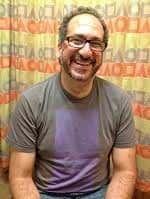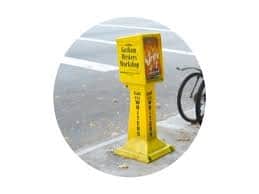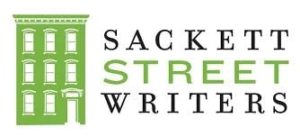Even if you have zero interest in writing, you’ve probably seen a cab-yellow newsstand of catalogs for Gotham Writers Workshop, or the lime green advertisements for Sackett Street Writers Workshop. Since 2002, Sackett Street has worked with over 3,500 writers, and Gotham Writers (founded in 1993) currently averages 2,800 New Yorkers a year with their in-person classes. But trumping both of these two well-known programs is the less publicly glitzy group, New York Writers Coalition (NYWC). Founded in 2002, NYWC has worked with over 15,000 writers.
Their high numbers are due to the fact they’re public and don’t charge for classes. If you’ve seen creative writing workshop notices at a Brooklyn Public library, there’s a good chance it was arranged by NYWC. While Gotham and Sackett focus on literary writing (notice the stress on ‘workshop’ in their name) NY Writers Coalition is community-driven (the root word of ‘coalition’ is ‘coalesce’). They work to include veterans, seniors, at-risk youth, and people living with disabilities. In fact, their story began at a homeless shelter.
Shortly after graduate school at City College, Aaron Zimmerman, the founder of NYWC, was invited to run a poetry workshop at The Prince George Hotel, a homeless shelter in NoMad. He had just completed training at Amherst Writers & Artists, a group that emphasizes the value of positive comments in writing groups. He applied what he learned from AWA to the workshop; the results were inspiring.
“There were fantastic writers,” Zimmerman said. “Those beginnings were really eye-opening for me to work with people who came from different backgrounds. It shattered all the stereotypes out there.”
He returned to The Prince George to lead workshops in fiction and organize readings. Once he realized he could help low-income people and those living with HIV through writing workshops, Zimmerman was set on creating New York Writers Coalition.
As NYWC grew, Zimmerman focused on maintaining the connection between the arts and social justice. “How can we use the power of writing to change conceptions, bring people together, provide space? That’s why the focus is on people from groups that historically aren’t heard from enough.”
NY Writers Coalition is all about removing class and racial barriers to writing. Zimmerman said that when they first started, that philosophy seemed like a radical idea. “But now we know how we thrive when we hear from more people.” He noted that writing classes continue to be expensive. “They do tend to serve the privileged–educationally, economically. A lot of barriers get in the way of people and over time, some think they just can’t do it.”
Since 2005, NYWC has hosted a free, six-week creative writing camp for teens in Fort Greene. They also run a small publishing press. Their first chapbook was from a Prince George Hotel writer who passed from AIDS. Since then, they’ve published over 45 books from their participants. This past January, they published Can You Feel the Free in Me, a collection of poems by women at their Rikers Island writing group.
The AWA Method Around Brooklyn
NYWC doesn’t officially sponsor any method, but it’s hard to ignore the influence of Amherst Writers & Artists (AWA). Founded by Pat and Peter Schneider, the AWA method posits that the space where something is written is more important than instructions on how to write. According to their website, their philosophy “ is a simple one: every person is a writer, and every writer deserves a safe environment in which to experiment, learn, and develop craft.”
A typical workshop looks like this: writers sit in a circle and go over the ground rules–only positive criticism, everything is to be treated as fiction, the purpose of the group is to be supportive. The instructor gives a prompt, ranging from quotes to touch this lemon slice and write what memories come to you. After writing for 15-20 minutes, the group stops. The instructor asks who wants to share (AWA is unique among writing methods in that the instructor participates too). The group listens to what was written. Considering that the piece is brand new, all comments gravitate toward the positive elements. If time permits, there’s a round two.
You’d be surprised at what we can create in the span of 20 minutes.
– Paul Rozario-Falcone, Safe Space Stories
It’s not for everyone. Writing with others can feel uncomfortable when performing a traditionally solitary activity. Some of this fresh material can be wrenching to listen to, and parts of the process can become an exercise is in positivity gymnastics. More professional writers still gravitate toward Sackett and Gotham. But for the majority of people who want to dabble in writing, who fear having their work shared, who have a distress they want to explore, want to connect with a community, or recover from a sour MFA experience, this kinder, gentler method can be a literal life-saver.
Lynne Connor started the AWA-inspired group Lost Lit after her adoptive mother, who kept her breast cancer diagnosis a

secret, passed. After an AWA workshop in San Francisco where the prompt was a cotton ball, she tapped into some startling thoughts about Asian-American identity. For Connor, the AWA method was more generative than a traditional MFA program. “I couldn’t survive the MFA without this method,” Connor said.
With everything in AWA considered fiction, Connor said this focused the conversation on craft, and removed some of the unproductive comments she encountered in her nonfiction MFA courses.
The group’s name comes from her own experience: turning to literature when she felt lost. Since 2012, Lost Lit holds regular meetings of 10-12 people in a secluded loft area at Grumpy Bert Art Gallery (owned by her husband) in Boerum Hill.
With treating everything as fiction and the focus on positive comments, Connor re-built the confidence to share her work with others. With two small children, Connor finds that parents respond well to AWA: there’s no homework, and the only writing discussed in the class is generated in that class.
“Part of why I love this method is that I really see the change,” Connor said. “I can see the people who are petrified to read then by the end of six or eight weeks–they’re reading and their voice has changed. You can see themselves feel good about themselves.”
Lost Lit is just one of several smaller writing groups around Brooklyn using the AWA method. At Red Hook’s Jalopy Theater, Leslie Fierro has been running Cast Off Writers for the past two years. Paul Rozario-Falcone manages Safe Space Stories in Carroll Gardens.

After a law degree and an editing career, Rozario-Falcone signed up for an AWA workshop through NY Writers Coalition about four years ago.
“I was so impressed how it jump starts your creative process,” he said. “The environment is so friendly and warm, really anyone can use this method.”
Eager to learn more, Rozario-Falcone (like Connor) attended an AWA “bootcamp” in Amherst. For a week, they took turns leading workshops and enacting specific participant personas. They would spot the group dynamic, such as the writer whose feedback was more self-involved than focused on the piece at hand. They also wrote based off of dozens of prompts. “You’d be surprised at what we can create in the span of 20 minutes,” he said.

They learned that the space in which writing is discussed is just as important as how it is discussed. “This method fosters creation of a space that is safe for anybody. It’s nonjudgmental and allow your own voice to develop slowly. We learn by each other through positive feedback. The goal isn’t to say you don’t understand something, it’s to oo and awe.”
AWA workshops aren’t completely opposed to criticism. Each of these smaller groups offer manuscript critiques, which are held less frequently. Lost Lit offers a “Works in Progress” for people who want more direct feedback on a manuscript that’s ready for publication. “I don’t love doing those,” Connor admitted. “It’s hard with different people coming in various stages of completion. Some people are just not ready to take the critique that comes out.”
All three instructors see a great range of professions attend their classes. Fierro’s current participants include teachers, lawyers, advertisers, college students, and recent graduates. She’ll often spread the word through Parent ListServs, and she’s found that parents with young children get a lot from AWA workshops. Fierro, who received her MFA from The New School in fiction, says Cast Off Writers offers opportunities for people who want to write but are weary of the critique.
“When the group only comments on what’s strong or memorable, the rest of your writing will rise,” Fierro said. “Everybody can find a place for their voice.”
In a video celebrating NY Writers Coalition 15th anniversary, a string of participants talked about the personal change they experienced from these writing groups. They mentioned reduced pain and stress, a boost in confidence and self-esteem, a replacement for addictive behaviors, a connective path to other cultures, genders, situations and religions. It has built self-respect and reduced depression.

All four of these instructors agreed that the relaxed environment inspires real-time improvement.
After 20 years of leading workshops, Zimmerman is still amazed by the change that occurs in just one hour. “Something magical happens. You can just see the power of receiving everyone’s feedback on that person: something melts, something transforms.”
When a writing group focuses on building trust, it allows a huge array of ages, races, and classes to participate. NYWC may not churn out the best writing in New York, but it does offer a sprawling network of opportunities for New Yorkers to feel some stability in their own lives and connection with their community.
“Our New Yorker stories have similar elements,” Zimmerman said, “and it’s a great thing to witness. If you can tell a story, you can write it down. That goes for everyone.”















2 Comments
Pingback: New York’s Most Popular Writing Method You’ve Never Heard Of
Thank you so much for this great article! Well done. Aaron is perfectly suited to this method and has done wonders for NYC. We’re using AWA in western mass with women who’ve been or are incarcerated (with Voices from Inside) and it is life’s great pleasure to see people change and grow…and become themselves. The changes for some of us-myself included- run deep, in the simple act of writing together, reading aloud and being heard, truly listened to. This article makes me very happy.